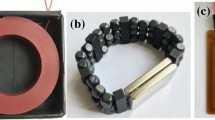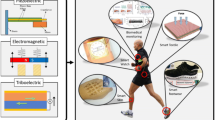Abstract
It is known that the human body contains rich chemical energy, part of which is converted to mechanical energy of up to 200W when in motion. Therefore, it is ideal to harvest human body kinetic energy to power mobile electronic devices. This paper presents an energy harvester to unintentionally extract human kinetic energy and directly convert it to electricity, which can serve as a power source for portable electronics. The proposed harvester mainly consists of an eccentric rotor made of permanent magnet, electric steel and coils as stator. The eccentric rotor, as a simple pendulum, acts as the kinetic energy harvester, which can absorb the motion from the human body during walking. With the permanent magnets on the rotor, the moving rotor can produce a changing magnetic field, where electric coils can induce electricity. A torsion spring is also added onto the rotor such that the harvester works even when placed on a horizontal plane where the gravitational acceleration fails. The electromagnetic and kinematical model is built to analyze the performance. Numerical analysis and system optimization are also conducted. Simulation shows that the harvester with 40mm diameter and 50g weight, worn on the wrist, can produce dozens of milliwatts of electricity during normal walking.
Similar content being viewed by others
References
J. Colomer-Farrarons, P. Miribel-Catala, A. Saiz-Vela, M. Pui-Vidal and J. Samitier, Power-conditioning circuitry for a self-powered system based on micro PZT generators in a 0.13μm low-voltage low-power technology, IEEE Transactions on Industrial Electronics, 55(9) (2008) 3249–3257.
A. Khaligh, P. Zeng, X. Wu and Y. Xu, A hybrid energy scavenging topology for human-powered mobile electronics, 34th Annual Conference of IEEE Industrial Electronics, (2008) 448–453.
D. Dondi, A. Bertacchini, D. Brunelli, L. Larcher and L. Benini, Modeling and optimization of a solar energy harvester system for self-powered wireless sensor networks, IEEE Transactions on Industrial Electronics, 55(7) (2008) 2759–2766.
J. T. Bialasiewicz, Renewable energy systems with photovoltaic power generators: Operation and modeling, IEEE Transactions on Industrial Electronics, 55(7) (2008) 2752–2758.
L. Rome, L. Flynn, E. M. Goldman and T. D. Yoo, Generating electricity while walking with loads, Science, 309 (2005) 1725–1728.
J. M. Donelan, Biomechanical energy harvesting: Generating electricity during walking with minimal user effort, Science, 319 (2008) 807–810.
T. Starner and J. Paradiso, Low-power electronics design, Chapter 45, CRC Press, New York (2004).
B. Gutnik, H. Mackie, G. Hudson and C. Standen, How close to a pendulum is human upper limb movement during walking, HOMO—Journal of Comparative Human Biology, 56(1) (2005) 35–49.
D. Webb, R. Tuttle and M. Baksh, Pendular activity of human upper limbs during slow and normal walking, American Journal of Physical Anthropology, 93(4) (2005) 447–489.
S. Dwari, R. Dayal and L. Parsa, A Novel direct AC/DC converter for efficient low voltage energy harvesting, 34th Annual Conference of IEEE Industrial Electronics (2008) 484–488.
Author information
Authors and Affiliations
Corresponding author
Additional information
Recommended by Guest Editor Dong-Ho Bae
Longhan Xie was born in China in 1978. He received his Bachelor’s degree in 2002 and Master’s degree in 2005, both from Zhejiang University, China, and his Ph.D. in 2010 from the Chinese University of Hong Kong. Currently, he is an assistant professor in the School of Mechanical and Automotive Engineering, the South China University of Technology. His areas of research include product design, CAD/CAE and energy harvesting.
Ruxu Du is a professor in the Dept. of Mechanical and Automation Engineering. He is also the director of the Guangzhou Chinese Academy of Science (CAS) Institute of Advanced Technology. His areas of research include: design (mechanical watch and clock, industry sewing machine and etc.) and manufacturing (metal forming, machining, plastic injection molding and etc.), as well as energy and materials. He is a Fellow of ASME.
Rights and permissions
About this article
Cite this article
Xie, L., Du, R. Harvest human kinetic energy to power portable electronics. J Mech Sci Technol 26, 2005–2008 (2012). https://doi.org/10.1007/s12206-012-0503-7
Received:
Revised:
Accepted:
Published:
Issue Date:
DOI: https://doi.org/10.1007/s12206-012-0503-7




